Robotics in Manufacturing
Are you looking to enhance your existing line processes through robotic integration? If you are unsure where to begin your journey, start by reading here. Robots are changing the manufacturing industry and will continue to do so throughout the coming years. Many business owners are adopting automation processes within their production lines for numerous reasons.
By the end of this post, you should have a thorough understanding of industrial robotics and how automation can help your business grow and remain competitive.
Table of Contents:
History of Robotics
Robotics in Manufacturing
Types of Industrial Robots
How Does Robotics Integration Work?
Integrating Robotics: Advantages vs. Disadvantages
The Future of Robotic Integration
History of Robotics
Robots have been around since the 1940s and have since been introduced into many industries. According to IEEE Robotics and Automation Society (IEEE RAS), robotics is “defined to include intelligent machines and systems used, for example, in space exploration, human services, or manufacturing; whereas automation includes the use of automated methods in various applications, for example, factory, office, home, or transportation systems to improve performance and productivity."
So where did the origin of robotics begin? Robotics research and development began in the mid-20th century with a focus in the industrial environment. The idea of robots lifting heavy objects and performing repetitive and dangerous tasks became an attractive option over human labor. As a result, American inventor George Devol designed the first industrial robot, Unimate, in the 1950's. In 1961, Devol deployed Unimate at General Motor’s assembly line at a die casting plant. This revolutionized the automotive industry. General Motors became the first automated factory in the world.
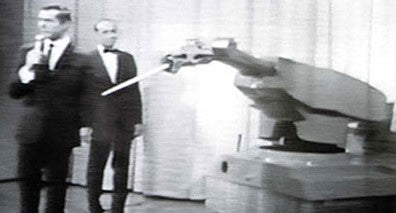
Robotics in Manufacturing
The introduction of robot integration became a breakthrough innovation for manufacturing industries. Automating tedious and difficult tasks with the use of robotics revolutionized the industry. Today, robotics are applied in manufacturing systems to improve performance, productivity, and work quality.
Robots are classified as either fixed or mobile based on the environment in which they function. Since fixed robots are best suited in well-defined environments, they are most used in manufacturing. Mobile robots, on the other hand, are designed for ill-defined and changing environments, especially ones that involve humans and animals.
Industrial robots are programmed to complete specific, repetitive tasks. Usually, the object or material is already set in place for the machine to manipulate. Technologies like sensors and vision systems are integrated into robots for guidance and feedback. Sensors are utilized for robot builds in order to identify colors, locate parts/components, check timing/errors, and maintain quality assurance. Types of sensors include inductive proximity switches, photoeyes, and fiber optics.
On the other hand, vision systems such as 1D, 2D and 3D technologies are used for more complex sensor designs. 1D sensors are commonly used to inspect parts one at a time as they move on a conveyor while 2D sensors can process parts more quickly in various resolutions. 3D vision systems involve multiple cameras that can provide part orientation information in real-time.
Vision systems provide more flexibility than simple sensors. They can be programmed quickly and provide useful data in real-time between PLC and robot over ethernet.
Want to learn more about PLCs? Read our TecTalk blog "PLCs Explained: Programmable Logic Controller Basics."
Common industrial robot applications in manufacturing include:
- Assembly
- Material handling
- Packing, Picking and Palletizing
- Part Transfer
- Machine loading
- Welding
- Painting
Robotic Assembly
Assembly robots are utilized to assemble, fix, press, fit, insert and disassemble materials or products. These robots use sensors and sensor fusion components to function. Assembly line robots pick products off conveyor belts and place them at a desired location. They are used in many industries that demand accuracy and cleanliness within their production line such as pharmaceuticals, manufacturing and automotive. Integrating assembly robots into your processes will help keep your operational costs down as they perform without staff and minimize day-to-day operations.
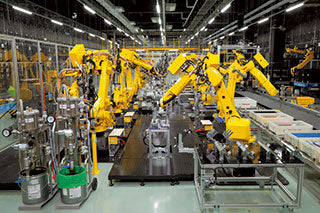
Robotic Material Handling
Certain dangerous tasks, such as moving, packing and/or transferring materials,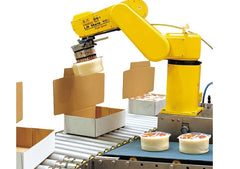 are often automated with the use of robotics. You can find material handling robots deployed in warehouses and distribution centers. Application of robots in material handling include palletizing, packing, machine loading, and part transfer. Since industrial robots can work at a faster speed over human workers, integrating material handling robots will increase your production output. Robots will also be able to cut labor costs as the amount of staff needed to perform will no longer be needed.
are often automated with the use of robotics. You can find material handling robots deployed in warehouses and distribution centers. Application of robots in material handling include palletizing, packing, machine loading, and part transfer. Since industrial robots can work at a faster speed over human workers, integrating material handling robots will increase your production output. Robots will also be able to cut labor costs as the amount of staff needed to perform will no longer be needed.
Robotic Picking, Packing and Palletizing
Picking and packing robots can perform several functions after the product has been assembled. These robots pick individual parts, pack accordingly and palletize at a fast speed. Given their ability to pick and pack at a higher speed rate, robotic picking and robotic packing can increase your productivity with precision.
Robotic Part Transfer
Part transfer robots move heavy materials from one location of the building to another. Transferring large and heavy parts is both dangerous and difficult for humans, not to mention time consuming. Part transfer robots offer a safe solution to keeping your workers out of hazardous environments and injury-free. Integrating part transfer robots will allow you to reduce your labor costs and speed the production process.
Robotic Machine Loading
Machine loading robots are utilized in operations where parts are loaded and unloaded at a production line. The process of loading and unloading parts on a machine can become difficult and cause injuries to human workers. Integrating machine loading robots will protect your workers from possible injuries, increase production and dispose of tedious, repetitive tasks. Your employees will be able to focus on the more important details of their jobs.
Robotic Welding
Robotic welding machines are used to automate the welding process by performing the weld and directly handling the part. Welding robots are commonly used in arc and spot welding where the welding process requires accuracy and speed. They are common in the automotive industry because of their accuracy. By automating the welding process, you will be meet faster cycle times, produce better weld quality, and cut labor costs. Integrating robot welding will also create a safer work environment for your workers. Your employees will no longer have to worry about arc burns, overspray, or inhaling hazardous smoke.

Robotic Painting
Industrial paint robots are primarily used in the automotive industry to paint parts and equipment evenly without leaving paint marks or drips. They are precise and spray each piece of equipment with the right amount of paint without wasting supply. Outside of the automotive industry, paint robots have recently been used to recreate original paintings.
Industrial painting robots are designed slim enough to reach small areas and nooks that would be difficult and time consuming for human workers. Their slim design also allows painting robots to fit in tight places and save floor space. They can be mounted on walls, shelves or rails to save space within factories. Integrating painting robots will improve your overall work quality by producing top quality results, save money on paint supply, and keep your workers safe from a hazardous painting work environment.

Types of Industrial Robots
By now you should have a clear understanding of the types of robots in manufacturing. Now we can dive into the classification of industrial robots. Industrial robots are typically categorized according to their mechanical structure. This section will explain each robot’s movement, industry application and axis configuration.
The 4 major types of robots in manufacturing are:
- Articulated Robots
- SCARA Robots
- Cartesian Robots
- Delta Robots
Articulated Robot
Articulated industrial robots are the most common type found in  manufacturing. Industrial robots have several joints that provides certain movements or positions. In robotics, joints are referred to as an axis and each axis provides the degree of freedom (movement). Articulated robots can have up to 10 or more joints, or axes, connected at the base. They have more degrees of freedom than any other industrial robot. Articulated robots are used in packing, painting, welding, material handling and dispensing applications. The most common type of articulated robot operates on a 6-axis configuration. They can pick and handle both small and large work pieces and perform small, detailed jobs. An example of a working articulated robot would be the FANUC M10 series, a pick and place specialist for pay loads up to 10 kg with 6-axis control.
manufacturing. Industrial robots have several joints that provides certain movements or positions. In robotics, joints are referred to as an axis and each axis provides the degree of freedom (movement). Articulated robots can have up to 10 or more joints, or axes, connected at the base. They have more degrees of freedom than any other industrial robot. Articulated robots are used in packing, painting, welding, material handling and dispensing applications. The most common type of articulated robot operates on a 6-axis configuration. They can pick and handle both small and large work pieces and perform small, detailed jobs. An example of a working articulated robot would be the FANUC M10 series, a pick and place specialist for pay loads up to 10 kg with 6-axis control.
Cartesian Robot
The cartesian robot is commonly used in manufacturing for CNC machines and 3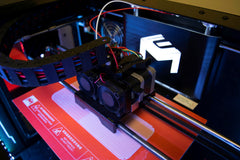 D printing. Cartesian robots operate on three or more linear axes using the Cartesian coordinate system (X, Y, and Z). Their coordinates allow them to move side to side, in and out, and up and down. Cartesian robots work in a rectangular workspace that allows them to reach most of the working area. These types of robots are positioned to work “over” their workspace, saving floor space. Cartesian robot application includes pick and place, dispensing, assembly and inspection.
D printing. Cartesian robots operate on three or more linear axes using the Cartesian coordinate system (X, Y, and Z). Their coordinates allow them to move side to side, in and out, and up and down. Cartesian robots work in a rectangular workspace that allows them to reach most of the working area. These types of robots are positioned to work “over” their workspace, saving floor space. Cartesian robot application includes pick and place, dispensing, assembly and inspection.
SCARA Robots
SCARA robots, or Selective Compliance Articulated Robots, are used for  assembly applications. SCARA robots perform at a faster speed than cartesian robot systems and are suitable for small assembly lines. Compared to cartesian and delta robots, SCARA robots have the smallest footprint. They operate on a 4-axis configuration and perform in vertical assembly tasks between two parallel planes - like transferring parts from a tray to a conveyor. An example of this robot is the FANUC SCARA, which has a payload of 4kg and can reach 400mm. Its design allows it to operate in small parts assembly. These robots are used in applications such as pick and place, assembly, inspection, packaging and dispensing.
assembly applications. SCARA robots perform at a faster speed than cartesian robot systems and are suitable for small assembly lines. Compared to cartesian and delta robots, SCARA robots have the smallest footprint. They operate on a 4-axis configuration and perform in vertical assembly tasks between two parallel planes - like transferring parts from a tray to a conveyor. An example of this robot is the FANUC SCARA, which has a payload of 4kg and can reach 400mm. Its design allows it to operate in small parts assembly. These robots are used in applications such as pick and place, assembly, inspection, packaging and dispensing.
Delta Robots
Delta robots consist of three arms connected at the base and only move in the X,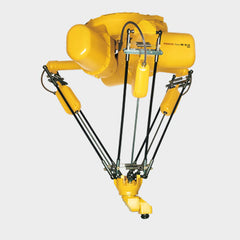
Y, and Z direction with no rotation. They are often referred to as “spider robots” because of their slim, lightweight arms and ability to move at a high speed. Some delta robots can execute up to 300 picks per minute. Delta industrial robots are widely used in food, pharmaceutical, and electronic manufacturing industries. They are primarily utilized in picking and packaging applications, however, they can also be used in assembly and inspection. Just recently, delta robots have been used in 3D printing.
How Does Robotics Integration Work?
By now you have learned about the different types of industrial robot applications. Each industrial robot requires a distinctive end of arm tool that allows the robot to perform a specified movement. Below are unique robot applications and examples used within many production lines.
Pick and Place Robot
Pick and place robots are common in manufacturing environments. These robots are deployed on production lines to automate the process of picking up items and placing them at their desired locations. In the video below, the robots work together in assembling contact lens packaging by picking up individual components and placing them in the correct location of the assembly process.
Tool to Part Robot
The tool to part application requires the industrial robot to move a specific tool to an item or part. A custom rivet machine is an example of a tool to part robot. In the video below, the robot picks and places rivets onto each loaded metal sheet using a rivet gun. The second machine can read the finished piece, through cameras and sensors, and dispense into the appropriate bin.
Part to Tool Robot
Part to tool industrial robots are used to move items or materials to the appointed tool. The robot keeps constant contact between the part and tool throughout the process. The video below demonstrates a small working assembly cell where the robot is programmed to pick the material and move it to a Lance-N-Loc press. As you can see, the robot maintains contact with the metal sheet and the press machine tool.
Integrating Robotics: Advantages vs. Disadvantages
Many businesses are integrating robotics into their production lines since it provides long term ROI and increased productivity. As you have learned, industrial robotics automates processes that can be dangerous and tedious. Human labor is often unpredictable and at times inconsistent. Robotics can not only provide accuracy but consistency. Here are some advantages and disadvantages when using robotics to automate your needs.
Advantages of Robotic Integration
Increased profitability: Integrating robotics will improve profitability by reducing resources when completing tasks. Robotics will increase your process efficiency and create perfect work quality each time.
Quality labor: Integrating robotics into your current line process will increase accuracy and consistency throughout the entire work process. Each product or material will be given the same amount of detail and precision. By choosing automation, companies no longer need to worry about sick days, unexpected emergencies, or poor work quality.
Longer work hours: Industrial robots work at a faster speed without the need to take breaks or pauses. Also, robots can perform repetitive tasks at a higher production rate. Your employees can now pass tedious and time-consuming tasks to robots. Your staff can now focus on more complex tasks.
Increased safety: Safety is one of the most important advantages when integrating robotics. Keeping your environment and workers safe is crucial for all business owners and plant managers. Dangerous and harmful tasks can now be assigned to robots. Employees will no longer have work with heavy objects and/or in hazardously hot settings. Companies will also be able to save money from injuries at the workplace and resulting lawsuits.
Job creation: Although robotics can perform more efficiently than human labor, they do not eliminate jobs. Robots do not take jobs away from humans but instead provide more job opportunities. Without humans, industrial robots are just simple machines. Robots cannot function by themselves and will need humans to program their tasks. Integrating robots within your production line will only enhance current jobs. Your employees will have the opportunity to develop new tech and engineering skills. The advantages of industrial robots are endless for your business and employees.
Disadvantages of Robotic Integration
Capital cost: At first glance, the initial capital investment may discourage many business owners from robotics integration. It is important to understand what this investment means to your company long-term. You must consider costs including installation, configuration, and any possible future modifications. It is recommended that you seek the investment needed and calculate the expected ROI before attempting to integrate robotics.
Needed Expertise: Deploying your industrial robot takes training and expertise from an automation company. Seeking the right automation team with certified professionals is crucial when integrating robots. Companies will also need time to train their existing employees to program and interact with their new robotics system.
Limitations of robots: Robots can have their own limitations as well. Although industrial robots remain an attractive alternative over human labor, there are still tasks robots cannot perform. Robots depend upon their surrounding systems such as vision systems, grippers, conveyors, and PLCs to complete tasks. Complex tasks require more time to plan and program.
The Future of Robotic Integration
As COVID-19 continues to change the economy as well as many industries, the robotic market is not immune to COVID effects. Although the market revenue growth for robotics will not reach the forecasted revenue, industrial robots are still seen as a potential investment. Automation is expected to become more important for many businesses in order to keep minimal human contact and remain competitive. Industrial robots are now prompting many industries to adopt automation. The industrial robot market accounts for the majority of robotic spends and will most likely benefit from the current situation.
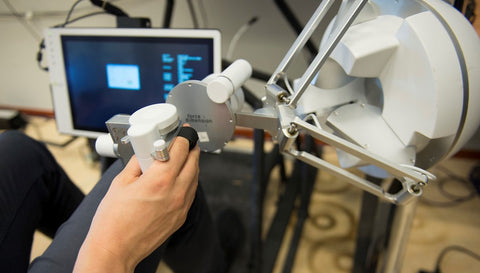
In the past, robots have worked and performed separately from humans and other machines; however, robots today can be integrated into the workforce and some can even work beside human workers. Thanks to advancements in sensor technology, robots can now execute tasks that were once too tedious or dangerous to humans. Now, researchers are finding ways to make robots perform as data collectors. In manufacturing, collecting data from robots will be able to help manufactures make better decisions in the future and help their manufacturing processes. As of now, many researchers and companies are looking forward to the introduction of Artificial Intelligence (AI) and how AI will be able to reshape the future of robotics capabilities in the coming years.
Want to learn more about industrial automation? Read our TecTalk blog "Understanding Industrial Automation in Industry 4.0."
Conclusion:
Robotic integration continues to be a popular choice of automation for many business owners and plant managers. The advantages of integrating robotics into your production line are endless. Industrial robots perform repetitive, tedious tasks with accuracy and consistency. Robots will not only be able to work faster for shorter periods, but also increase production rates, ROI, and create new jobs. However, big decisions call for research and understanding. Integrating robotics into your environment requires investment, calculating your expected ROI, and embracing changes and certain limitations.Integrating robotics is a complex undertaking that requires more than just researching and building a system. It is important to choose an integrator that has the experience to design an efficient system. When choosing a robotics integrator be sure to select an automation group with the latest available technologies in sensors, vision systems, grippers, conveyors, and PLCs. It is also important to seek a certified team of technicians and engineers that can design and deliver quality results to meet your business goals. We understand that every business is different and requires unique custom approaches when building robotics solutions. If you are unsure where to start, you can call or email us for more questions.